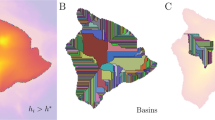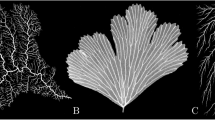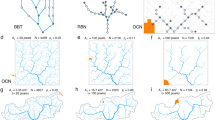Abstract
STREAM networks evolve by headward growth and branching away from escarpments such as rift margins. The structure of these networks and their topographic relief are known to be fractal1–3, but no model so far has been able to generate the observed scaling properties. Here I present a statistical model of network growth in which stream heads branch and propagate at a rate that depends only on the local strength of the substrate. This model corresponds to the process of invasion percolation4, with the added requirement of self-avoidance; it is a self-organized critical system5 with properties similar to those of standard percolation models6. A description based on self-avoiding invasion percolation reproduces the known scaling behaviour of stream networks, and may provide a valuable tool for delineation of drainage patterns from digital topographic data sets7,8.
This is a preview of subscription content, access via your institution
Access options
Subscribe to this journal
Receive 51 print issues and online access
$199.00 per year
only $3.90 per issue
Buy this article
- Purchase on Springer Link
- Instant access to full article PDF
Prices may be subject to local taxes which are calculated during checkout
Similar content being viewed by others
References
Mandelbrot, B. B. The Fractal Geometry of Nature (Freeman, New York, 1982).
Huang, J. & Turcotte, D. L. J. geophys. Res. 94, 7491–7495 (1989).
Thornes, J. Nature 345, 764–765 (1990).
Wilkinson, D. & Willemsen, J. F. J. Phys. A 16, 3365–3376 (1983).
Bak, P., Tang, C. & Wiesenfeld, K. Phys. Rev. A38, 364–374 (1988).
Stauffer, D. Introduction to Percolation Theory (Taylor & Francis, London, 1985).
Band, L. E. Water Resour. Res. 12, 15–24 (1986).
Jenson, S. K. & Domingue, J. O. Photogram. Engng Remote Sens. 54, 1593–1600 (1988).
Leopold, L. B. & Langbein, W. B. US Geol. Survey Prof. Pap. 500-A, 1–20 (1962).
Howard, A. D. Geogr. Anal. 3, 29–51 (1971).
Takayasu, H., Nishikawa, I. & Tasaki, H. Phys. Rev. A 37, 3110–3117 (1988).
Hjelmfelt, A. T. Jr Water Resour. Bull. 24, 455–459 (1988).
Rosso, R., Bacchi, B. & La Barbera, P. Water Resour. Res. 27, 381–387 (1991).
Hack, J. T. US Geol. Survey Prof. Pap. 294-B, 1–97 (1957).
Gray, D. M. J. geophys. Res. 66, 1215–1223 (1961).
Weissel, J. K. Pacific Rim Congress 90, Proc. v. III, 63–70 (Austral. Inst. Min. and Metall, Parkville, Vic., 1990).
Havlin, S. & Ben-Avraham, D. Adv. Phys. 36, 695–798 (1987).
Havlin, S., Nossal, R. & Trus, B. Phys. Rev. A 32, 3829–3831 (1985).
Herrmann, H. J. & Stanley, H. E. J. Phys. A 21, L829–L833 (1988).
Hinrichsen, E. L., Måløy, K. J., Feder, J. & Jøssang, T. J. Phys. A 22, L271–L277 (1989).
La Barbera, P. & Rosso, R. Water Resour. Res. 25, 735–741 (1989).
Shreve, R. L. J. Geol. 77, 397–414 (1969).
Dhar, D. & Ramaswamy, R. Phys. Rev. Lett. 54, 1346–1349 (1985).
Smart, J. S. Bull. geol. Soc. Am. 80, 1757–1774 (1969).
Meakin, P. J. Phys. A 20, L1113–L1119 (1987).
Meakin, P., Majid, I., Havlin, S. & Stanley, H. E. J. Phys. A 17, L975–L981 (1984).
Mandelbrot, B. B. & Evertsz, C. J. G. Nature 348, 143–145 (1990).
Strahler, A. N. Handbook of Applied Hydrology (ed. Chow, V. T.) 4–11 (McGraw-Hill. New York, 1964).
Author information
Authors and Affiliations
Rights and permissions
About this article
Cite this article
Stark, C. An invasion percolation model of drainage network evolution. Nature 352, 423–425 (1991). https://doi.org/10.1038/352423a0
Received:
Accepted:
Issue Date:
DOI: https://doi.org/10.1038/352423a0
This article is cited by
-
Advances, challenges and perspective in modelling the functioning of karst systems: a review
Environmental Earth Sciences (2023)
-
Fracturing ranked surfaces
Scientific Reports (2012)
Comments
By submitting a comment you agree to abide by our Terms and Community Guidelines. If you find something abusive or that does not comply with our terms or guidelines please flag it as inappropriate.



